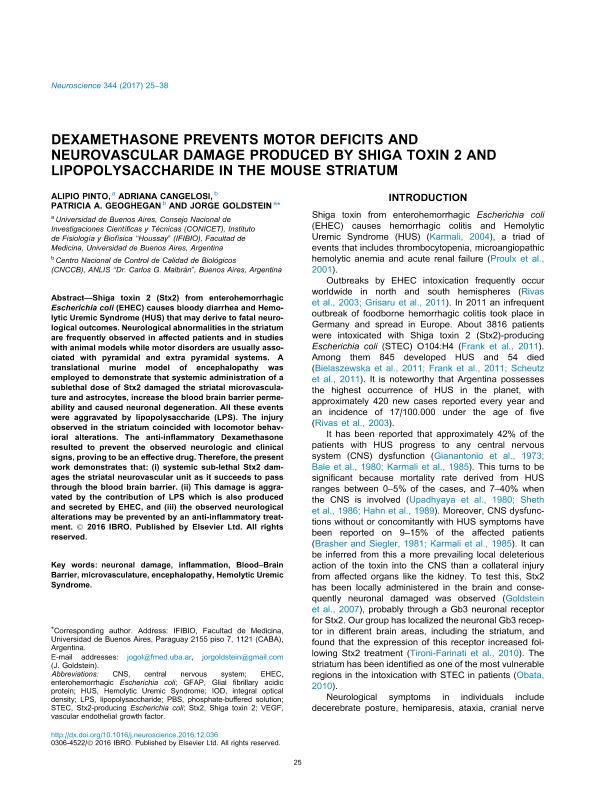Artículo
Dexamethasone prevents motor deficits and neurovascular damage produced by shiga toxin 2 and lipopolysaccharide in the mouse striatum
Vasconcelos Esteves Pinto, Alipio ; Cangelosi, Adriana; Geoghegan, Patricia A.; Goldstein Raij, Jorge
; Cangelosi, Adriana; Geoghegan, Patricia A.; Goldstein Raij, Jorge
 ; Cangelosi, Adriana; Geoghegan, Patricia A.; Goldstein Raij, Jorge
; Cangelosi, Adriana; Geoghegan, Patricia A.; Goldstein Raij, Jorge
Fecha de publicación:
03/2017
Editorial:
Pergamon-Elsevier Science Ltd
Revista:
Neuroscience
ISSN:
0306-4522
Idioma:
Inglés
Tipo de recurso:
Artículo publicado
Clasificación temática:
Resumen
Shiga toxin 2 (Stx2) from enterohemorrhagic Escherichia coli (EHEC) causes bloody diarrhea and Hemolytic Uremic Syndrome (HUS) that may derive to fatal neurological outcomes. Neurological abnormalities in the striatum are frequently observed in affected patients and in studies with animal models while motor disorders are usually associated with pyramidal and extra pyramidal systems. A translational murine model of encephalopathy was employed to demonstrate that systemic administration of a sublethal dose of Stx2 damaged the striatal microvasculature and astrocytes, increase the blood brain barrier permeability and caused neuronal degeneration. All these events were aggravated by lipopolysaccharide (LPS). The injury observed in the striatum coincided with locomotor behavioral alterations. The anti-inflammatory Dexamethasone resulted to prevent the observed neurologic and clinical signs, proving to be an effective drug. Therefore, the present work demonstrates that: (i) systemic sub-lethal Stx2 damages the striatal neurovascular unit as it succeeds to pass through the blood brain barrier. (ii) This damage is aggravated by the contribution of LPS which is also produced and secreted by EHEC, and (iii) the observed neurological alterations may be prevented by an anti-inflammatory treatment.
Archivos asociados
Licencia
Identificadores
Colecciones
Articulos(IFIBIO HOUSSAY)
Articulos de INSTITUTO DE FISIOLOGIA Y BIOFISICA BERNARDO HOUSSAY
Articulos de INSTITUTO DE FISIOLOGIA Y BIOFISICA BERNARDO HOUSSAY
Citación
Vasconcelos Esteves Pinto, Alipio; Cangelosi, Adriana; Geoghegan, Patricia A.; Goldstein Raij, Jorge; Dexamethasone prevents motor deficits and neurovascular damage produced by shiga toxin 2 and lipopolysaccharide in the mouse striatum; Pergamon-Elsevier Science Ltd; Neuroscience; 344; 3-2017; 25-38
Compartir
Altmétricas



